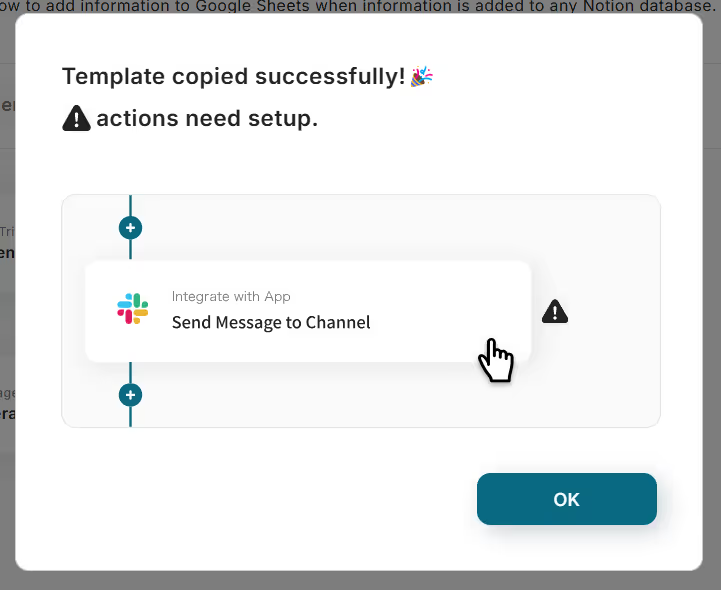
When the message "Template has been copied!" appears, click "OK" to complete the copy.

Next, click on "Health Check Form Submission" to edit the template.

① You can preview the question form you created. You can check it even while editing.
② You can edit the title and description (optional) of the question form.

① You can set the title and description (optional) of the question.
② You can choose the operation to perform in the question section. In the image, "Attachment" is selected.
③ You can add a new question section. Please add it optionally if multiple check items are required.
④ You can hide the Yoom logo. Use this if you do not want to display the Yoom logo at the bottom of the question form page.

Also, by clicking "+ Add text above the submit button", you can optionally edit the text displayed on the button.
Use this when you want to change the text from "Submit".

Scroll down to edit the "Completion Page Settings" after form submission.
① You can set the heading of the completion page. By default, "Submission Complete" is displayed.
② You can optionally add a description. If not needed, leave it blank.
③ You can set the display related to Yoom. Turn on this button if you want to hide it.
④ You can set access restrictions. Use this when using it internally only.
⑤ You can set the activation of the flow bot. You can choose whether only the administrator can activate it or if it activates upon form submission.
Once each setting is complete, click "Next".

① You can check the display of the "Response Page" and "Completion Page" you created earlier.
② In "Acquired Values", you can set sample values to be used in the next flow test. Please set the name and file for testing. The file will be read later with OCR.

This time, I entered "Test Taro" for "Name" and selected a file like the one in the image for "Health Check Form".
Once each item is set, click "Save".

Next, set up to read the text of the health check form using OCR.
Click "Read text from image/PDF".
* AI operations are only available with the Team Plan and Success Plan. If you are on the Free Plan or Mini Plan, the operations of the flow bot you have set will result in an error, so please be careful.

On the next screen, you can optionally edit the "Title".
Without changing the "Action", click "Next".

Next, we will proceed with the detailed settings for reading.
In "File Attachment Method", you can choose between "Use Acquired Values" or "Upload File".
This time, since we will use the file selected in "Acquired Values" earlier, we chose "Use Acquired Values".
In "Items to Extract", you can specify the items you want to extract from the health check form. You can optionally add or delete items, so it is recommended to specify each item while comparing it with the health check form you plan to submit.
In "AI to Use", you can select the AI to perform the reading. This time, we selected Chat GPT.

Also, please enter the items set in "Items to Extract" into the Excel sheet where the data will be stored.
* For instructions on how to set up Excel, please refer to here.
Once each item is set, click "Test".

When "Test Successful" is displayed, check whether the contents described in the file have been acquired.

Similarly, please check whether the acquired content is reflected in the "Output".
Once confirmed, click "Save".
Step 3: Set Actions

Next, set the action to save diagnostic data to Microsoft Excel.
Click "Add Record".

On the next screen, please edit the title optionally and confirm the account.
Once complete, scroll down the page.

Set up the database integration.
① "File Storage Location" can be selected from "OneDrive" or "SharePoint". This time, we selected SharePoint.
② Select the location where the Excel file is stored with "Site ID". For OneDrive, it will be displayed as "Drive ID".
③ Specify the target Excel file with "Item ID".
④ Specify the sheet where the data will be saved with "Sheet Name".
⑤ Optionally specify the table range where the data will be saved with "Table Range".
Once each setting is complete, press "Next".

Next, set the "Values of the Record to Add".
Click on each item field and set the data that corresponds to each item from the output.
Once each item is set, click "Test".

Once you confirm the test is successful, click "Save".

Once the trigger is set to ON, the flow operation is ready.

After setting the trigger to ON, you can click "Copy Form Link".
Now, when the form is answered, the diagnostic data will be automatically saved to Excel.




















.avif)
.avif)







